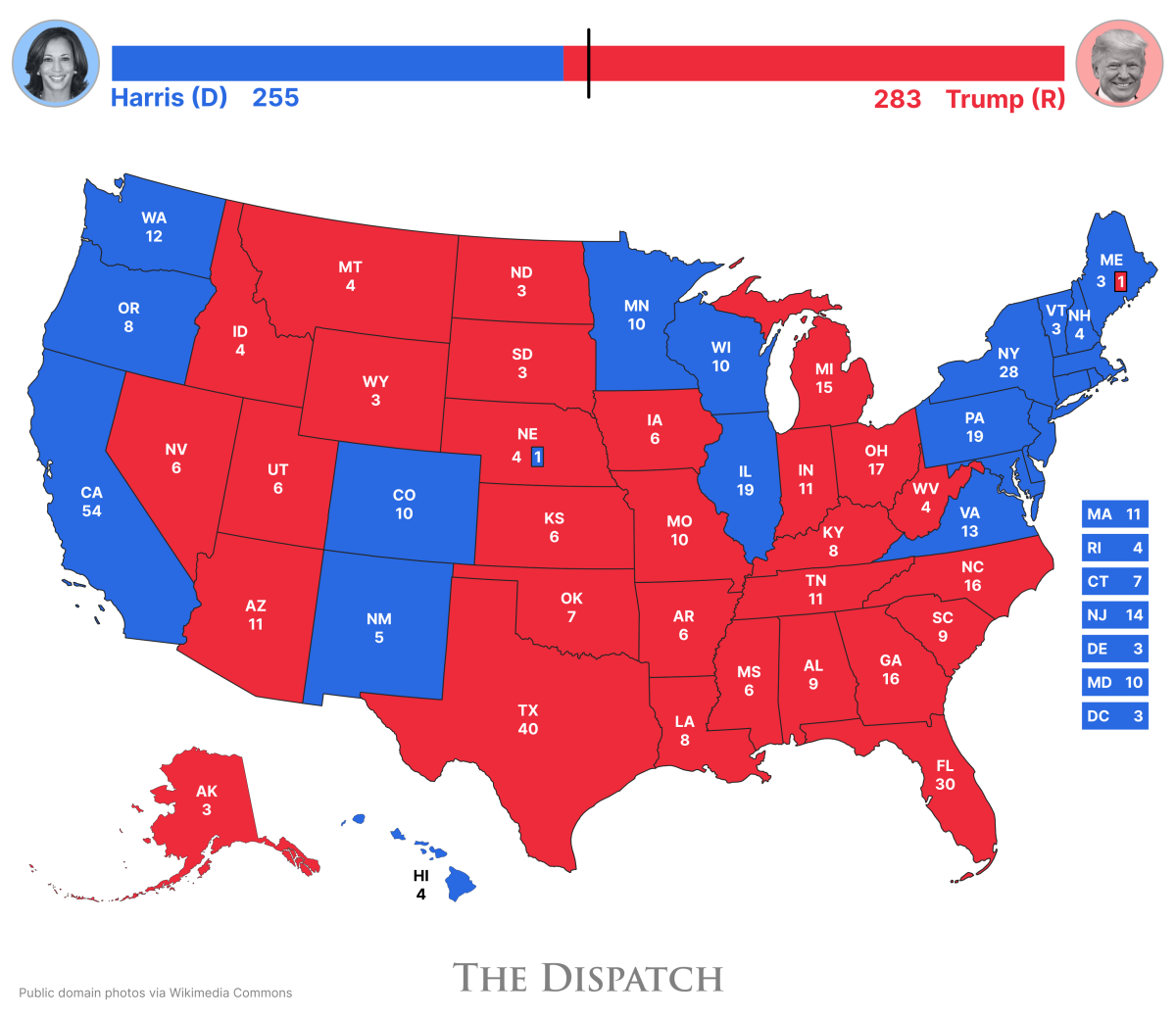Happy Tuesday! Election Day is seven days away. Anyone think we’ll know for sure who the next president will be in one week’s time?
Up to Speed
- Vice President Kamala Harris will deliver her closing argument in a speech on the National Mall this evening, and ABC News cites a senior official on her campaign in reporting she will “give an optimistic and hopeful message that's focused on moving forward.” She chose the location because it’s the same place where former President Donald Trump spoke to supporters on January 6, 2021, some of whom then stormed the Capitol. Harris’ speech comes as she has leaned more into the idea that Trump is a threat to democracy while on the campaign trail, saying in a CNN town hall last week she believes her opponent is a fascist.
- Steve Bannon, an ally of former President Donald Trump and host of the War Room podcast, was released from federal prison today after serving about four months following his conviction for contempt of Congress. Bannon’s podcast has declined in popularity as he has served his sentence and guest hosts have taken his place, but his release puts an influential far-right voice of the Trump GOP back into the mix a week before Election Day. He is scheduled to hold a press conference in New York after leaving prison in Connecticut, but there is speculation he could travel to Allentown, Pennsylvania, to speak at a rally for the former president later today.
- Washington Post owner Jeff Bezos explained the reasoning behind his paper’s decision not to endorse a candidate for president in next week’s election, arguing it is a step toward the publication regaining trust from the public. “Presidential endorsements do nothing to tip the scales of an election,” he wrote in a Monday column. “No undecided voters in Pennsylvania are going to say, ‘I’m going with Newspaper A’s endorsement.’ None. What presidential endorsements actually do is create a perception of bias. A perception of non-independence.” Bezos’ op-ed comes as the Post has lost more than 200,000 subscribers in the wake of the decision, according to NPR.
Eight Ways the Electoral Map Could Shake Out
With one week to go before Election Day, it’s time to start wrapping our heads around all the plausible outcomes in the Electoral College.
Theoretically, any combination of states is a possible path to at least 270 electoral votes and victory for either major-party candidate, but based on previous voting patterns, we can presume most of the electoral map is set. Donald Trump will win solid red states from Alabama to Wyoming, while Kamala Harris will win the reliably blue states like California and Massachusetts. Under our reasonable assumptions about what are the given red and blue states, we can presume that Trump will begin with 219 electoral votes and Harris with 226. (This is also assuming, by the way, that Trump will win one of Maine’s congressional districts and Harris will win one of Nebraska’s, which, under those states’ laws, will award them each a single electoral vote in states they will otherwise lose.)
What’s left, of course, are the battleground states. Readers of Dispatch Politics will no doubt be familiar with all seven battlegrounds this year: Arizona, Georgia, Michigan, Nevada, North Carolina, Pennsylvania, and Wisconsin. Winning all seven states would amount to an electoral landslide for either candidate, and polling suggests it’s possible.
What is more likely is that Trump and Harris will split the battlegrounds. But how they split them will matter a lot. It may be worthwhile to break up the seven battlegrounds into a few groups, to understand the possible splits. There are:
- The Blue Wall battlegrounds: Pennsylvania, Michigan, and Wisconsin. These three states have voted the same way in every presidential election since 1992, and in all but one of them, 2016, they voted for the Democratic nominee.
- The Sun Belt swayers: Arizona and Georgia. Both of these states have voted the same way since 2000, almost always going Republican. Joe Biden was able to bring both into his column in 2020, but just barely.
- The Nearly Theres: Nevada and North Carolina. Nevada hasn’t gone Republican since 2004, and North Carolina voted for Barack Obama in 2008 but not for another Democrat since. Every presidential election, both parties have reason to believe they can flip these states into their column, but a victory always seems to slip through their fingers. Could this be the year one or both parties finally land their white whale?
To put a fine point on it, the race remains exceedingly close. Any presumption that these states will act as they traditionally have should be thrown out the window. Yes, the Blue Wall battlegrounds consistently vote together, but that is only true until it isn’t. The Sun Belt swayers may have had just temporary flirtations with Democrats, but it’s conceivable Harris could eke out a win in one of them, or both of them, again. Nevada seems ripe for the picking for Trump, but despite Democrats’ best efforts, North Carolina could remain just out of reach.
We’ve taken a look at some potential Electoral College breakdowns. This is hardly an exhaustive list of every permutation, but these maps should give you an idea of just how many paths to 270 electoral votes there are.
A Hole in the Blue Wall: Trump 283, Harris 255

All it takes is one of the three Blue Wall battlegrounds to fall for Trump to win a majority, and why not Michigan? The expectation is that all three will continue to vote in concert, but the truth is that the margins have been so close in recent elections that any extra factor—say, a protest vote against the Biden administration by Michigan’s significant Arab American population—could tip one state but not the others. In another version of this map, it could be Wisconsin or Pennsylvania that goes red. Whichever it is, a single break in the wall would mean an overall Trump victory even if Harris hangs on in Nevada but can’t get enough votes elsewhere in the Sun Belt.
A Trump Near-Rout: Trump 302, Harris 236

This is what Trump is looking at if there’s further erosion of the Blue Wall. Harris may be able to hang on to Wisconsin here, but without winning the swing states of Georgia and North Carolina, there’s no hope for the vice president. Even with this map, Trump can afford to lose Nevada and still have a relatively massive Electoral College victory.
The Blue Wall Holds: Harris 270, Trump 268

This is the ultimate squeaker win for Harris, and it would have those Blue Wall battlegrounds remain in the Democratic camp even while losing Nevada to Trump. It doesn’t get much closer than this. There’s always the possibility that if the three big Midwestern battlegrounds go with Harris that reliable Nevada will, too, which would bump up Harris’ electoral total to 276. But the Silver State’s unique profile and trajectory suggests it could look more like the Sun Belt states in this scenario.
The New South: Harris 302, Trump 236

Here’s where things get interesting in terms of defining some new coalitions. A reverse in raw numbers from the previous map, this path to a big Harris margin runs not just through holding the Blue Wall states but also building on top of the Biden coalition in Georgia and North Carolina by turning out larger numbers of black voters than any of the polling currently suggests. That’s where the Democratic turnout machine could come into play, and it would hedge against a Trump recovery in Arizona and his gains among Latino and working-class voters in Nevada.
A Trump Sweep: Trump 312, Harris 226

If Trump wins every one of the battlegrounds, he’ll have the largest Electoral College win for a Republican since George H.W. Bush’s monster 1988 win of 426 electoral votes. This is not just a plausible outcome; if voters perform exactly as the poll averages suggest, Trump will sweep the battlegrounds. That’s a big “if” of course, but in most of the battleground states, Trump’s margins are small enough that Harris could conceivably win them all, too. In fact …
A Harris Sweep: Harris 319, Trump 219

Given Harris’ underdog status, this map looks and feels less likely than the Trump sweep, but it’s not crazy to contemplate, either. This would be an improvement on Biden’s 2020 performance, which also makes it seem hard to believe, but it’s also somewhat behind Obama’s performance in 2012, back when Florida was not only in contention but still a bellwether.
Just For Fun: Trump 339, Harris 199; Harris 359, Trump 179


Would either of these blowouts be a smart bet? Hardly. But surprises have happened before, so why not consider them? In the Trump blowout, not only does he win every battleground state but he even breaks through in states Republicans have been dreaming of for years: Minnesota, New Hampshire, and even Virginia—where it just so happens Trump is holding a rally during this final weekend of the campaign.
On the flip side, Democrats would hardly believe their luck if Harris somehow swept the battlegrounds but also had the distinction of finally turning Texas blue. That hasn’t happened since Jimmy Carter took Texas in 1976. But Harris, who campaigned with Beyoncé in Houston last week, is still reaching for the Lone Star.
Eyes on the Trail
- President Joe Biden travels today to Baltimore, where he will deliver remarks on his domestic agenda. From there, Biden heads to Potomac, Maryland, before ending the day back at the White House.
- Vice President Kamala Harris delivers a speech this evening at the Ellipse in Washington, D.C.
- Former President Donald Trump “delivers remarks to the press” this morning at Mar-a-Lago, his winter residence and private social club in Palm Beach, Florida. In the afternoon, the Republican nominee campaigns in Drexel Hill, Pennsylvania, at a “Building America’s Future” event, joined by former Arkansas Gov. Mike Huckabee. In the evening, Trump hosts a rally in Allentown, Pennsylvania.
- Minnesota Gov. Tim Walz campaigns for Harris today in Georgia, with an afternoon stop in Savannah and an evening stop in Columbus.
- Sen. J.D. Vance of Ohio hosts a Trump campaign rally this afternoon in Saginaw, Michigan. Later in the afternoon, the Republican vice presidential nominee hosts a Trump campaign rally in Holland, Michigan.
- Second gentleman Doug Emhoff campaigns for Harris today in Las Vegas, with a stop at the University of Nevada, Las Vegas, to encourage students to support the vice president.
- Lara Trump, co-chair of the Republican National Committee, this morning headlines a Team Trump Women’s Tour event in Las Vegas. In the evening, she headlines a similar Trump campaign event in Phoenix.
- Robert F. Kennedy Jr., a former Democrat who waged an independent presidential bid, and Tulsi Gabbard, a former Democratic congresswoman from Hawaii, campaign for Trump this evening in Madison, Wisconsin.
- West Virginia Gov. Jim Justice campaigns for Trump this evening in Clarion, Pennsylvania, joined by his pet English Bulldog, “Babydog.”
Notable and Quotable
“Wow! York County, Pennsylvania, received THOUSANDS of potentially FRAUDULENT Voter Registration Forms and Mail-In Ballot Applications from a third party group. This is on top of Lancaster County being caught with 2600 Fake Ballots and Forms, all written by the same person. Really bad ‘stuff.’ WHAT IS GOING ON IN PENNSYLVANIA??? Law Enforcement must do their job, immediately!!! WOW!!!”
—Former President Donald Trump in a Truth Social post, referring to investigations in York and Lancaster counties of potential fraudulent voter registration forms, October 28, 2024







Please note that we at The Dispatch hold ourselves, our work, and our commenters to a higher standard than other places on the internet. We welcome comments that foster genuine debate or discussion—including comments critical of us or our work—but responses that include ad hominem attacks on fellow Dispatch members or are intended to stoke fear and anger may be moderated.
With your membership, you only have the ability to comment on The Morning Dispatch articles. Consider upgrading to join the conversation everywhere.